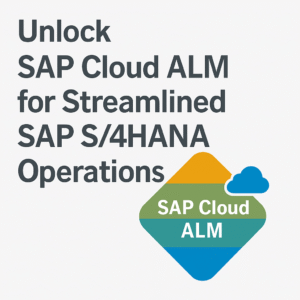
Unlock SAP Cloud ALM for Streamlined SAP S/4HANA Operations
Managing SAP S/4HANA systems doesn’t have to be a struggle. With the growing complexity of cloud-based environments, many businesses face challenges tracking implementation, operations, and performance. That’s where SAP Cloud ALM steps in. Built to keep up with modern business needs, this powerful platform helps teams stay organized, deliver projects faster, and run systems more smoothly.
Let’s explore how SAP Cloud ALM works and how it can simplify day-to-day tasks for SAP S/4HANA users.
What Is SAP Cloud ALM?
Think of SAP Cloud ALM as a control tower for your SAP landscape. It delivers the tools needed to plan, build, test, release, and operate SAP applications — all from one space.
SAP Cloud ALM focuses specifically on cloud solutions like SAP S/4HANA Cloud, but it also supports hybrid environments. Whether you use SAP services in the cloud, on-premise, or a bit of both, this tool keeps everything connected and under control.
Why Do Modern Businesses Need SAP Cloud ALM?
Businesses are turning to cloud models because of flexibility, quicker releases, and reduced costs. But managing different cloud services without a unified system can get chaotic. SAP Cloud ALM:
- Improves collaboration between teams working on SAP implementations
- Increases visibility into system health, performance, and issues
- Reduces manual work through automation and integrations
It’s not just another fancy dashboard. It’s a full lifecycle management tool designed to match today’s dynamic digital environments.
The Key Capabilities of SAP Cloud ALM
SAP Cloud ALM covers two major areas: Implementation and Operations. Here’s how each one works.
Smooth Implementations, Right From Day One
Implementing SAP S/4HANA can be a huge project. There’s planning, testing, setting up integrations, and lots of back-and-forth between consultants and business users. SAP Cloud ALM simplifies this process with purpose-built features:
- Project and task management: Assign roles, set deadlines, and track progress from one place.
- Fit-to-standard analysis: Map your business needs to SAP solutions and identify gaps early.
- Automation and guidance: Get preloaded content and step-by-step guides aligned with SAP Activate methodology.
Instead of starting from scratch or relying on spreadsheets, teams can follow repeatable, trackable processes. That means fewer delays and faster go-lives.
Stay in Control with Built-in Operations Tools
Once SAP S/4HANA is up and running, you still need to monitor its health and performance. That’s where the operations side of SAP Cloud ALM comes in.
- Health monitoring: Keep systems running smoothly with real-time alerts and statuses.
- Job monitoring: Track background jobs and avoid delays in business processes.
- Integration monitoring: Spot and fix data flow issues across connected systems.
- Business process monitoring: Ensure end-to-end processes — like order-to-cash — work as expected.
This level of visibility allows IT teams to fix issues quickly — often before users notice anything’s wrong.
It’s Cloud-First for a Reason
Unlike older ALM tools, SAP Cloud ALM is designed for the cloud. That changes everything.
No more installing software, maintaining servers, or applying manual updates. SAP handles the infrastructure, so you can focus on your business. The platform updates automatically with new features and capabilities in the background.
This helps support agility. When SAP rolls out quarterly feature releases, you can adopt them quickly, knowing your ALM tools are already compatible. You’re always a step ahead — without lifting a finger.
How Does It Compare to SAP Solution Manager?
Some SAP users may already be familiar with SAP Solution Manager, an on-premise ALM tool. So how is SAP Cloud ALM different?
- Lightweight and faster to set up
- No infrastructure maintenance — it’s fully managed by SAP
- More intuitive UI with better project and operations visibility
- Built for SAP cloud products with integration into S/4HANA Cloud, SAP Signavio and more
SAP recommends SAP Cloud ALM for cloud and hybrid environments, while Solution Manager is typically used for larger on-premise landscapes.
Licensing and Availability
One of the best parts? SAP Cloud ALM is included with your SAP cloud subscriptions — there’s no extra fee to worry about. You just need to activate it for your landscape.
If you’re running SAP S/4HANA Cloud, SAP Business Technology Platform (BTP), or other SAP cloud products, you’re eligible to use SAP Cloud ALM. That makes it easier than ever to get started with lifecycle management on day one.
Where SAP Cloud ALM Fits in the Big Picture
SAP is moving toward a cleaner, more integrated cloud ecosystem. SAP Cloud ALM plays a big part in this strategy:
- It supports SAP S/4HANA Cloud, public edition — the main direction for digital transformation.
- It aligns with SAP Business Technology Platform (BTP). So ALM isn’t just managing core ERP functions, but also app extensions, analytics, and integrations.
- It works together with SAP Signavio for business process modeling, and SAP Central Business Configuration for scoping and setup.
Everything connects. Instead of relying on multiple tools or custom methods, businesses can manage SAP operations with one central approach.
Getting Started with SAP Cloud ALM
Activating SAP Cloud ALM doesn’t require a technical deep dive. Here’s how new users typically get going:
- Request tenant access via SAP support site (SAP for Me)
- Assign user roles based on responsibilities (project lead, developer, admin, etc.)
- Define projects, set up landscape connections, and link built-in monitors
From there, you can start tracking project progress, managing integrations, and monitoring operations — all from a single screen.
Use Case Examples: Real-World Benefits
Let’s put this into perspective with simple scenarios.
Scenario 1: Mid-size retail company launching S/4HANA
The IT team uses SAP Cloud ALM to define project timelines, assign responsibilities, and track configurations. They use task lists tailored to the retail industry, guided by SAP’s best practices. They go live four weeks ahead of the original schedule.
Scenario 2: Manufacturing company running hybrid landscape
Operations teams struggle with batch jobs failing overnight, but they don’t find out until noon. After setting up job monitoring in SAP Cloud ALM, alerts now trigger immediately. The team resolves issues proactively, avoiding downtime.
These stories show how the platform aids not only system admins but project managers and business users too.
Takeaway: SAP Cloud ALM Helps You Stay Ahead
SAP Cloud ALM gives businesses the structure and visibility needed to master SAP S/4HANA operations. From keeping implementation lean to spotting problems early, it turns complexity into clarity.
If your team is planning a move to the cloud — or already running cloud services — this tool can act as your day-to-day assistant. It’s light, powerful, and requires no extra investments or maintenance.
Want faster project rollouts? Fewer operational headaches? Better monitoring? Then SAP Cloud ALM might just become your new favorite resource.
Explore Further
Ready to dive deeper? You can start with SAP’s official guide on SAP Cloud ALM:
Read the full article on SAP Community.
💡 TIP: Pair SAP Cloud ALM with SAP Signavio to get even more insight into your business processes and uncover opportunities for improvement.
—
Keywords :
SAP Cloud ALM, SAP S/4HANA operations, SAP lifecycle management, SAP monitoring tool, SAP cloud implementation, SAP application lifecycle management, ALM for SAP S/4HANA

